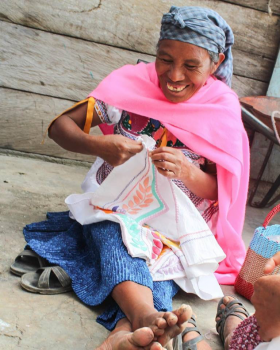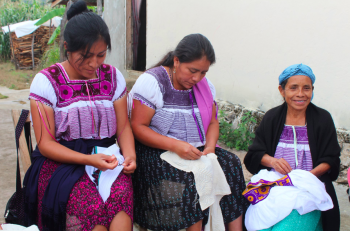By Professor R. Shaughnessy
Many women in and around the city of Chiapas, San Cristobal de las Cases (or Tzotzil), make traditional women’s clothing for sale in their communities and beyond. These indigenous designs, which typically include bright flowers on a white fabric, are passed down from generation to generation among the local Mayan community. Making clothing has long been an important income generating activity for disenfranchised women in Mexico’s poorest state.
Along come the global fashion corporations in search of the latest designs for their “fast fashion” lines. The Spanish multinational giant Zara has allegedly copied these traditional Mayan designs without permission or compensation. This is a compelling example of what has come to be known by many as “cultural appropriation”, which can be summarized as exploiting elements of a minority culture for commercial or other gain by members of a dominant culture.
 A small non-profit called Impacto is committed to helping women of two ethnic groups: Tsotsil and the Tseltal, both with Mayan background, with protecting their designs as intellectual property while building small or “micro” businesses that can generate fair and sustainable income. Adriana Aguerrebere, a graduate of Northwestern University and resident of Chiapas, founded this organization to pursue social and economic justice goals in partnership with the community. Her work on behalf of Chiapas’ indigenous artisan-entrepreneurs has risen to coverage in a recent edition of a widely-read business publication.
A small non-profit called Impacto is committed to helping women of two ethnic groups: Tsotsil and the Tseltal, both with Mayan background, with protecting their designs as intellectual property while building small or “micro” businesses that can generate fair and sustainable income. Adriana Aguerrebere, a graduate of Northwestern University and resident of Chiapas, founded this organization to pursue social and economic justice goals in partnership with the community. Her work on behalf of Chiapas’ indigenous artisan-entrepreneurs has risen to coverage in a recent edition of a widely-read business publication.
The Economist article entitled “Practicing an Ancient Craft in a Village Without Men” features a poor village called Aguacatenango in southern Chiapas where the men leave the community for nine months each year to find work elsewhere in Mexico, leaving the women to find ways to generate income for their families. A typical artisan dress stitched by a woman in this village will take up to 36 hours of work, earning as little as $6, or just 17 cents per hour.
On the intellectual property side of this unjust equation, the copyright laws are unclear and in need of reform. Most copyright provisions consider a fashion design as a utility and not a “work of creative expression or art” and therefore not subject to copyright protection. While it is true that some fashions design can be patented via design patent law, the cost of patent filing and prosecution is generally far too high for indigenous entrepreneurs to bear. That leaves the loosely defined common law idea of plagiarism as the remaining remedy for unauthorized copying.
 A further public policy question is whether an indigenous fashion design can belong to private citizens in the community where they have been passed down for generations or should instead be publicly owned by that community in the “commons”. In the latter case, any compensation for using the design outside of the community would be paid to the community and not individual entrepreneurs that have continued to make clothing based on those designs.
A further public policy question is whether an indigenous fashion design can belong to private citizens in the community where they have been passed down for generations or should instead be publicly owned by that community in the “commons”. In the latter case, any compensation for using the design outside of the community would be paid to the community and not individual entrepreneurs that have continued to make clothing based on those designs.
In the US, Congress has considered acting on this gap in copyright protection, but legislation has never made its way into law. There are many court cases on the reach of copyright into fashion, with the general outcomes being little to no copyright protection for most indigenous designs.
I think all can agree that we serve poor and low-income people best when we foster an environment in which they are free to take their economic futures into their own hands. Creating dignified work at a living wage (self-employment is all too often the only form of employment for women in certain cultures and communities) is preferable to aid or donations that can sometimes work counter to the shared goals of independence and self-sustainability.
We’ve seen what an idea like microfinance can do to empower disenfranchised women with access to affordable capital. It’s time for the copyright laws across the board to recognize the value of indigenous designs and require corporate infringers to either refrain from copying without permission or pay fair value for the use of cultural icons like indigenous textile designs.


